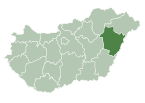Hajdúszoboszló
This article needs additional citations for verification. (June 2007) |
Hajdúszoboszló | |
|---|---|
| Nickname(s): | |
| Country | |
| County | Hajdú-Bihar |
| Government | |
| • Mayor | László Sóvágó dr. |
| Area | |
| • Total | 238.7 km2 (92.2 sq mi) |
| Population (2012) | |
| • Total | 23,309 |
| • Density | 99.3/km2 (257/sq mi) |
| Time zone | UTC1 (CET) |
| • Summer (DST) | UTC+2 (CEST) |
| Postal code | 4200 |
| Area code | 52 |
Hajdúszoboszló (Hungarian pronunciation: [ˈhɒjduːsobosloː]) is a town in Hajdú-Bihar county, Hungary, 19 kilometres (12 miles) southwest of county seat Debrecen. It is the third largest town in Hajdú-Bihar county.
Location
The town is located in the northeastern part of the Great Hungarian Plain. Three regions meet next to the town: the Hajdúhát ridge from the north-north-east, the Hortobágy National Park (Puszta) from the north-north-west, and the Great Sárrét and Berettyó region from the south. Szoboszló lies at a height of scarcely 100 to 110 metres (328–361 ft) above sea level and slopes down a little towards Hortobágy.
This is a landscape "where the earth and the skies meet", it is not a monotonous plain, not even for travellers accustomed to romantic mountains, since here and there the landscape is enlivened by the backwaters of the Tisza river with patches of reed, thousands of wild fowl, and inviting groves. The surroundings are the renowned puszta, the "glorious plain".
History
From historical data, scattered findings and archaeological explorations in recent years, this part of the Great Plain was inhabited as far back as the Great Migrations. Because of the natural resources and the convergence of trade routes, Huns, Vandals, Gepids, Goths, Avars, frequently alternated with one another in this area. In the first phase of the reign of the Árpád Dynasty, this area was inhabited by populous communities. The first written mention of Szoboszló dates back to 1075, when King Géza I. donated half of Szoboszló's royal duty taxes to the new abbacy to be established at Garamszentbenedek.
With his deed of gift, decorated with his coat of arms and dated on 2 September 1606, István Bocskai, Prince of Transylvania provided homes for 700 Hajdú (Heyduck) cavalrymen at the site of Szoboszló, which had formerly been destroyed by the Tartars of Crimea. This is why the prefix "Hajdú" was attached to the settlement's name of Slavonic origin. But this form - Hajdúszoboszló - only became widespread in the 19th century. The town led the customary, toilsome life of the small agricultural, stock-breeding towns of Hajdú County, until the end of the first third of the 20th century.
The upswing of the town commenced from 26 October 1925, with the breaking up of the thermal spring. The medicinal water received an ever-increasing role. The town's development into a resort place started and agriculture retained its significant role even after the discovery of the gas field.
Population
- 1870 - 12.269
- 1920 - 17.722
- 1970 - 22.003
- 2002 - 23.874
- 2005 - 23.827
- 2009 - 23.295

(for complete history see [1])
Spa complex
The official website http://hajduszoboszlo.hu/en/
This section is empty. You can help by adding to it. (July 2015) |
International relations
Twin towns — Sister cities
Hajdúszoboszló is twinned with:
 Bad Dürrheim, Germany
Bad Dürrheim, Germany Târnăveni, Romania (from 1990)
Târnăveni, Romania (from 1990) Kežmarok, Slovakia[1]
Kežmarok, Slovakia[1] Krynica, Poland
Krynica, Poland Luhačovice, Czech Republic
Luhačovice, Czech Republic Palanga, Lithuania
Palanga, Lithuania Valkeakoski, Finland
Valkeakoski, Finland Żyrardów, Poland
Żyrardów, Poland Lanškroun, Czech Republic
Lanškroun, Czech Republic
47°26′N 21°23′E / 47.433°N 21.383°E
Other links
- hajduszoboszlonoclegi.pl accommodation in Hajduszoboszlo
- vendegzona.hu accommodation in Hajduszoboszlo
- Hajdúszoboszló city's webpage
- All accommodations in Hajdúszoboszló hajduszoboszlo-szallas.lap.hu
- Great accommodation offers in Hajdúszoboszló www.szallasmagyarorszag.hu
- Hajdúszoboszló at funiq.hu
References
- Notes
- ^ "Oficiálne stránky mesta Kežmarok". kezmarok.sk. Retrieved 8 February 2010.



